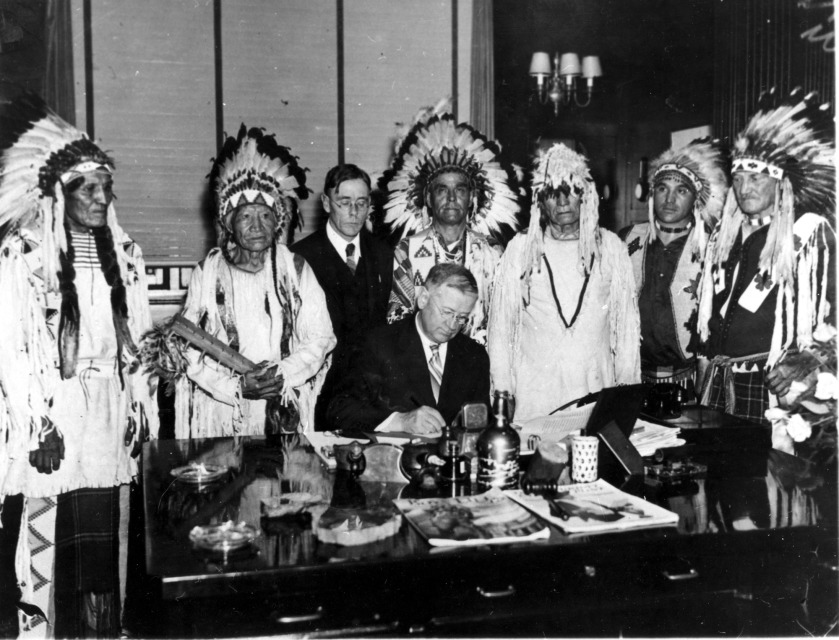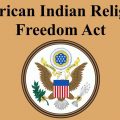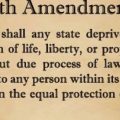
With the passage of the Indian Reorganization Act (IRA) in 1934, the United States government sought to bring economic development to Indian reservations by making them into a kind of corporation. Under the IRA, tribes could now enter into contracts and, more importantly, they could hire their own attorneys. Following World War II, government policies regarding Indian tribes changed. In order to pay for the reconstruction of Germany and Japan, the United States turned to the Indian reservations, the poorest sector of the country. If the United States could just get out of the “Indian business,” stop worrying about upholding any treaty obligations, and get the Indians to assimilate into American society just like immigrants, then this would free up money which could be spent overseas. Thus the United States began the process of dismantling the Indian tribes.
In 1950, Dillon S. Meyer was appointed as Commissioner of Indian Affairs. He had previously been in charge of the Japanese-American Relocation Camps during World War II. He ran the Bureau of Indian Affairs as a dictatorship with the goal of destroying Indian cultures and dismantling Indian reservations so that their resources could be developed by private, non-Indian, corporations. He viewed the existence of Indian cultures as “un-American” and a force that weakened the fabric of American society. Indians, according to Meyer, were helpless and unable to elevate themselves into the non-Indian world of mainstream America. From an Indian viewpoint, he was one of the worst, and perhaps the worst, Commissioner of Indian Affairs ever appointed.
While federal Indian policies during the Meyer regime reflected the larger Cold War and the strong anti-Communist sentiments of the time, Blackfoot tribal chairman George Pambrum would charge:
“The Indian Bureau is now using methods of Communist dictatorship against our people. … Stalin could learn a lot about how to run a dictatorship by watching the Indian Bureau.”
One of the major conflicts between Meyer and the Indian tribes stemmed from their desire to obtain legal counsel. One of his first acts was to issue new rules which required that all attorneys who contracted with the tribes had to have his personal approval. In response to the proposed rules, the Association on American Indian Affairs (1951: 1) editorialized:
“The proposed rules, by interfering with free choice of counsel, collide head-on with the due process guarantee of the Federal Constitution.”
In South Dakota, the Standing Rock Sioux attempted to hire their own attorney, to be paid out of tribal funds, to help in the negotiations regarding lands taken in the Pick-Sloan dam projects. The tribe wanted legal counsel which was totally independent from the politics of the Department of the Interior. However, Commissioner of Indian Affairs Dillon Meyer rejected their choice of an attorney and allowed only a one-year contract.
The attorney selected by the tribe, James Curry, was an outspoken critic of the Bureau of Indian Affairs and was one of a number of Indian claims lawyers against whom Meyer had a personal vendetta. The tribe protested Meyer’s decision to the Department of Interior, but the Department of the Interior did nothing as Meyer continued to publicly attack Curry.
In 1951, Dillon Meyer outlined his new Indian policy at a speech before the National Council of Churches. He announced that the private sector or state governments could better serve the Indian people and the time had come to weaken or dissolve the relationship between Indian tribes and the federal government. He asked that religious groups help Indians to assimilate into American society.
Following his “new” policy, the Commissioner of Indian Affairs notified all tribes that money for hiring private attorneys to represent tribal claims would no longer be available. The Commissioner explained that public money was being wasted on private attorneys when government attorneys could perform the same tasks. In other words, when Indians needed to sue the government, then they would have to use government attorneys, attorneys whose primary responsibility was defending the government against such suits. It was evident that Meyer wanted to take Indian litigation hostage and prevent Indians from having access to the court system.
In Nevada, the Commissioner of Indian Affairs denied the Pyramid Lake Paiute the right to hire their own attorney in settling a claim for disputed land on their reservation. Paiute tribal chairman Avery Winnemucca and a three-member delegation traveled to Washington, D.C. to demand a hearing with the Secretary of the Interior. They failed to see the Secretary and to gain support for their cause.
In 1951, the Standing Rock Sioux sent a delegation to Washington to obtain a hearing about their choice in an attorney to represent their interests. For 26 days the delegation camped out in the office of the Secretary of the Interior, lobbied in Congress, and gave interviews to the news media to present their case. Finally, the Secretary of the Interior overruled the Meyer’s decision about the tribe’s contract with the attorney of their choice. This was seen as a victory not only for the Standing Rock Sioux, but for all Indians. It appeared that Indian tribes would have the right to select their own attorneys and to make contracts on their own terms. However, Dillon Meyer managed to circumvent the decision of the Secretary of the Interior by refusing to allow the tribe to spend more than $300 per year for the attorney’s services. It should be pointed out that the money which was used for tribal attorneys was not from federal funds, but from tribal funds: money which they had obtained from leases and other tribal enterprises.
The Bureau of Indian Affairs in 1952 abandoned the Indian reorganization program started in 1934 and set out with enthusiasm to take the government out of the Indian business. The BIA intended to destroy bilateral United States-Indian treaties and to end the government’s commitment to its trusteeship obligations. With no legislative authority, Dillon Meyer made an offer to all Indian tribes to end their federal relationships. In the annual report of the Bureau of Indian Affairs, Meyer wrote:
“If any Indian tribe is convinced that the Bureau of Indians Affairs is a handicap to its advancement, I am willing to recommend to the Secretary of Interior that we cooperate in securing legislative authority to terminate the Department’s trusteeship responsibility to that tribe.”
Like many of the nineteenth and early twentieth century Commissioners of Indian Affairs, Meyer had little understanding of the needs and desires of Indian people or any concern over their culture and well-being.
In 1952, federal representatives from the Army Corps of Engineers and the Bureau of Indian Affairs met with the Standing Rock Sioux and the Cheyenne River Sioux to seek an agreement over lands taken from them under the Pick-Sloan dam projects on the Missouri River. The Standing Rock Sioux asked that they be allowed to spend $500 to have their attorney attend the conference with them. Dillon Meyer refused the request, calling it a “highjacking game.” The Secretary of the Interior, however, overruled Meyer’s decision.
Dillon Meyer’s lack of concern for the legal rights of Indians can be seen again in 1952 when he has a bill introduced to Congress which would authorize BIA law enforcement officers to carry arms, to make arrests, and to engage in searches and seizures for alleged violations of BIA regulations, both on and off the reservation. The proposed bill makes it clear that insofar as Fourth Amendment search-and-seizure rights were concerned, Indians had only a tenuous claim to these constitutional protections. The bill failed to pass.
The BIA also petitioned Congress for blanket authority to terminate trusteeship of land, to veto any tribal expenditures, and to remove tax-exempt status from Indian Country. The BIA also asked that the BIA be exempt from any review or correction in the courts. In other words, Dillon Meyer wanted his friends in Congress to put his agency above the law.
The Commissioner of Indian Affairs is a political appointment and with a new President in 1953, Glenn Emmons was appointed to the position. Emmons, who was from New Mexico, was a staunch supporter of Indian termination. His appointment was supported by the Navajo tribal council. While the conflict of legal representation calmed down somewhat under Emmons, the push by the federal government to get rid of any federal obligations toward Indian nations continued. The BIA continued to obstruct tribal contracts for legal services.




Leave a Reply